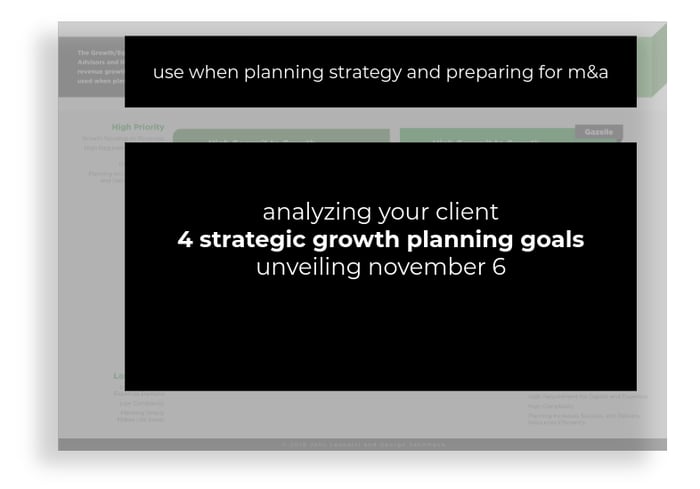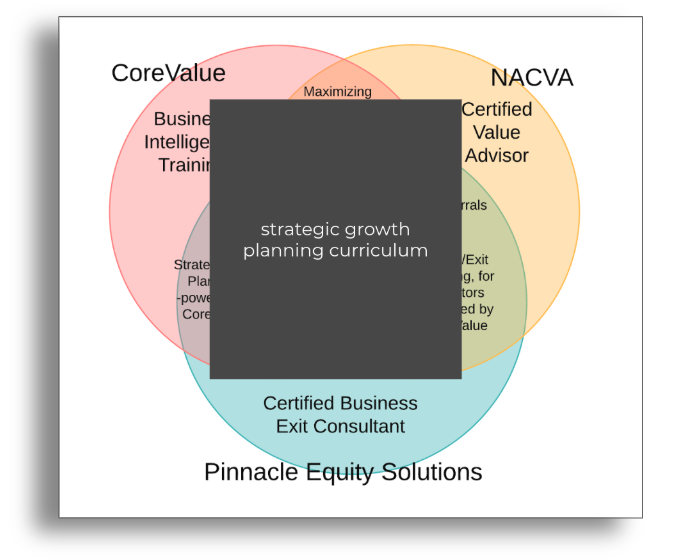What is Strategic Growth Planning?
You’ll soon be able to get Growth Planning training from top industry leaders, so let’s answer this basic question.
We’re going to start by asking how you define ‘Strategic Growth Planning.’ You can share your definition below, or email blog@corevalueforadvisors.com.
Here’s our take:
‘Strategic Growth Planning’ is the comprehensive process through which an organization identifies its growth goals, then documents the Growth Driver improvements needed to successfully progress from its current situation to its desired future situation. It’s the plan to create and maintain a strong, growing, and/or valuable company.
Conceptually it's as easy as 1-2-3:
- Identify Growth Goals
- Analyze Current Market and Operational Situation
- Document Necessary Changes
In practice you'll want training and technology delivering an effective, replicable process, supported by a thriving community of your peers.
Step 1: Identifying Growth Goals --revolutionary new training
You’ll get a major unveiling at the upcoming Business Advisor conferences, with participants learning about delivering this 1-2-3 process. This is powered by integrated technology and training from CoreValue Advisor Software, Pinnacle Equity Solutions, and the NACVA. You’ll start by learning why Strategic Growth Planning begins with discovery: where does the CEO want to go, and how committed is she to getting there?

Discovering growth goals looks something like this:

(We know, it’s as redacted as a CIA Report --but won't be for long.)
Here’s a sneak peek. We all know that most clients will invest their last dime to grow... and when clients say grow, they mean “grow revenues.” But we can’t assume that growing revenues cures all ills. If it did, all growing companies would easily access the private capital markets... and they don’t.
This is because there’s a second growth dimension: equity value. At some point, the business owners and CEO will care about equity value, and will want to convert that value into cash. At any one time that’s a tiny minority of companies. Moreover 83% of the time1 the enterprise value falls below expectations/requirements. What then? This is when you’ll need to help clients with equity planning and value growth.
value growth is a message that only resonates with a small segment of the market --use revenue growth messaging, we'll show you how
So which one does your client want? Revenue Growth? Value Growth? Both? You need to know before you can approach analysis and planning.
CoreValue and Pinnacle Equity Solutions are jointly introducing a growth/value matrix that will help you analyze your client’s growth goals using these two dimensions. This analysis in turn drives the priority given to the eighteen growth and value drivers of the generally accepted private business standards.2 Analyzing the eighteen growth and value drivers is at the heart of the Strategic Growth Planning curriculum. The results of your growth driver analysis, prioritized according to the growth/value matrix, feed your Strategic Growth Plan.
This starts the critical client conversation about the investment of time and treasure needed to reach their growth goal. Commitment is on a scale, the higher the commitment the more complex the engagement becomes. This is an incredible opportunity to highlight the value you bring as a growth planning expert: by hiring you the CEO avoids friction3 and wasted expense because Growth Planning considers all aspects of the business, not siloed individual areas.

You’ll have to come to the conference to learn the details. In 2020, Strategic Growth Planning classes will be offered through the NACVA and Pinnacle Equity Solutions. You've never had a better opportunity for learning to #drivegrowth in client companies and build a thriving practice.
[1] Source: Pinnacle Equity Solutions BERI data (c) 2019 Pinnacle Equity Solutions.
[2] CoreValue® US Patent 9,607,274
[3] “Drawing on his experience as an officer with a close perspective on both Frederick the Great and Napoleon Bonaparte, Carl von Clausewitz published an influential book called On War in 1832. In this work, he introduced the concept of “friction” as a hindrance to the execution of strategy. He used this term to describe the “myriad of small, but collectively numerous things that happen that cannot be foreseen or planned for, and which cause leaders to spend time on unforeseen decision making.” Clausewitz noted that no military or organizational unit can be thought of as a single or solitary piece: “each part is composed of individuals, every one of whom retains his potential for friction.” http://www.strategybydesign.org/friction. And as former Secretary of Defense General James Mattis, call sign Chaos, points out: ”the enemy gets a vote.” The enemy can be inside your client’s company, the competition, and/or the market itself.
[4] You can of course also work to create strategic value. Creating strategic value is a highly individualized process and beyond the scope of this article.
